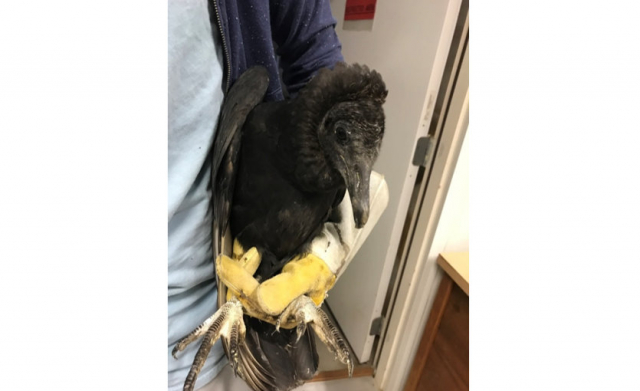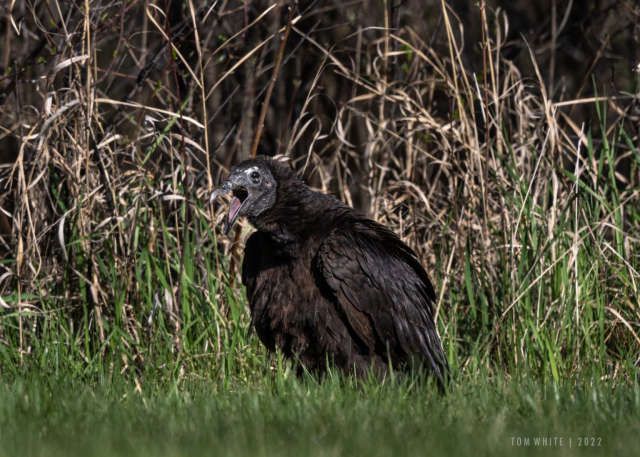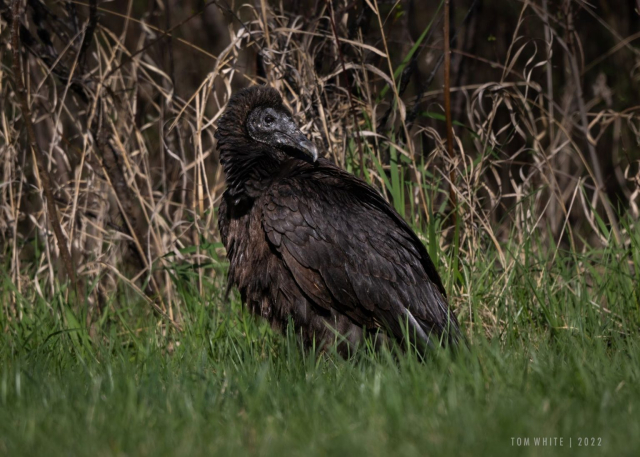Coragyps atratus
Status: Rare casual summer visitor.
Documentation: Specimen: HMM 2649, 14 Jul 1916 Hildreth, Franklin Co.
Taxonomy: No subspecies are recognized (AviList 2025).
Summer: There are three accepted records, 100+ years between the first and the most recent:
26 Apr 2022 Merganser Lake, Lancaster Co (Brogie 2023)
14 Jul 1916 Hildreth, Franklin Co (cited above)
23 Sep 2017 Lincoln, Lancaster Co (Brogie 2018).
The history of this species in Nebraska is poorly documented. There is a specimen at Hastings Municipal Museum (HMM 2649) collected 14 Jul 1916 in Franklin Co, and seven other reports and specimens with no or poor documentation, all pre-1963. There is no pattern to the dates of these old records.
A noteworthy event was the capture of an exhausted but uninjured immature Black Vulture in a Lincoln, Lancaster Co yard 23 Sep 2017; it was transferred to Raptor Recovery at Elmwood, and, after a stay, released in Oklahoma 23 Nov (Betsy Finch, personal communication). It appeared at the same time as a Magnificent Frigatebird, so likely an exhausted hurricane/tropical storm-driven bird. It is perhaps more than coincidental that the 1916 specimen cited above preceded a major hurricane that struck Texas a month later in Aug 1916; it seems possible the occurrence of this 1916 bird was in some way related to this hurricane. Amazingly, two observers independently found and photographed a single bird at Merganser Lake, Lancaster Co 26 Apr 2022 (Steve Kruse, Tom White; eBird.org). It could not be found subsequently and may have been pushed north to Nebraska by strong southerlies a few days prior.
Bray et al (1986) accepted a minimal description of three seen near Hordville, Hamilton Co 15 Mar 1963 (Gates 1964), but the date of the sighting is rather early relative to the few confirmed sightings from neighboring states and is probably best considered unconfirmed (see Comments).
There are about seven additional reports, most without details. One was collected by Talbot at Wolf Creek, Pawnee Co, before 1904 and placed in the University of Iowa collection (Bruner et al 1904), but none of the Black Vulture specimens now there collected by Talbot are labelled (Bray et al 1986). Brooking (Notes) mentions one taken by a boy near Kearney Oct 1918, mounted by Black, and now in the Olson collection at UNK; this specimen could not be located, although a specimen was described by Swenk (Letter dated 11 Oct 1918, NOU Archives) as collected by Black “on the 18th of last month,” thus 18 Sep 1918; a photograph was sent to Swenk with an offer to purchase the specimen, and it appeared to be “nicely mounted and in good plumage.” It seems likely that this is the specimen supposedly in the Olson collection discussed above. Additional reports, with few or no details, are Jan 1950 Keith Co (Johnsgard 1997), 7 Apr 1926 Sioux Co (Swenk 1927), 27 Apr 1955 Keya Paha Co, Apr 1951 Logan Co (Johnsgard 1997), and 3 May 2023 Keith Co, not accepted by NOURC (Brogie 2024).
Comments: The annual hawk watch at the Hitchcock Nature Center, only a few miles across the Missouri River in Iowa, has reported this species twice: one was seen 22 Sep 2002 and another on 20 Aug 2005 (eBird.org, accessed Oct 2023). The regular range reaches into extreme southeast Kansas, and sightings are increasing throughout the state (eBird.org, accessed Oct 2023; Thompson et al 2011). Reports are increasing in Iowa also; there are 12 records, spread throughout the year but most Jul-Oct (eBird.org, accessed Oct 2023). There are very few records north and west of Iowa and Kansas on the Great Plains: three in Colorado, all since 2004 and in Jul-Aug (CBRC), two in Wyoming in Apr-May, and single records for Montana in Sep, Alberta in Sep, Manitoba in Mar, and Minnesota in Jun (eBird.org, accessed Oct 2023).
Images
Abbreviations
CBRC: Colorado Bird Records Committee
HMM: Hastings Municipal Museum
NOU: Nebraska Ornithologists’ Union
NOURC: NOU Records Committee
UNK: University of Nebraska- Kearney
Literature Cited
AviList Core Team, 2025. AviList: The Global Avian Checklist, v2025. https://doi.org/10.2173/avilist.v2025.
Bray, T.E., B.K. Padelford, and W.R. Silcock. 1986. The birds of Nebraska: A critically evaluated list. Published by the authors, Bellevue, Nebraska, USA.
Brogie, M.A. 2018. 2017 (29th) Report of the NOU Records Committee. NBR 86: 131-142.
Brogie, M.A. 2023. 2022 (34th) Report of the NOU Records Committee. NBR 91: 114-122.
Brogie, M.A. 2024. 2023 (35th) Report of the NOU Records Committee. NBR 92: 132-138.
Brooking, A.M. Notes. Bird specimen records. Manuscript in NOU Archives, University of Nebraska State Museum, Lincoln, Nebraska, USA.
Bruner, L., R.H. Wolcott, and M.H. Swenk. 1904. A preliminary review of the birds of Nebraska, with synopses. Klopp and Bartlett, Omaha, Nebraska, USA.
Gates, D. 1964. Thirty-ninth Annual Cooperative Spring Migration and Occurrence report. NBR 32: 66-81.
Johnsgard, P.A. 1997. The birds of Nebraska and adjacent plains states. Occasional Papers No. 6, Nebraska Ornithologists’ Union. Lincoln, Nebraska, USA.
Swenk, M.H. 1927. Letters of Information 23: 8.
Thompson, M.C., C.A. Ely, B. Gress, C. Otte, S.T. Patti, D. Seibel, and E.A. Young. 2011. Birds of Kansas. University Press of Kansas, Lawrence, Kansas, USA.
Recommended Citation
Silcock, W.R., and J.G. Jorgensen. 2025. Black Vulture (Coragyps atratus). In Birds of Nebraska — Online. www.BirdsofNebraska.org
Birds of Nebraska – Online
Updated 13 Jul 2025



